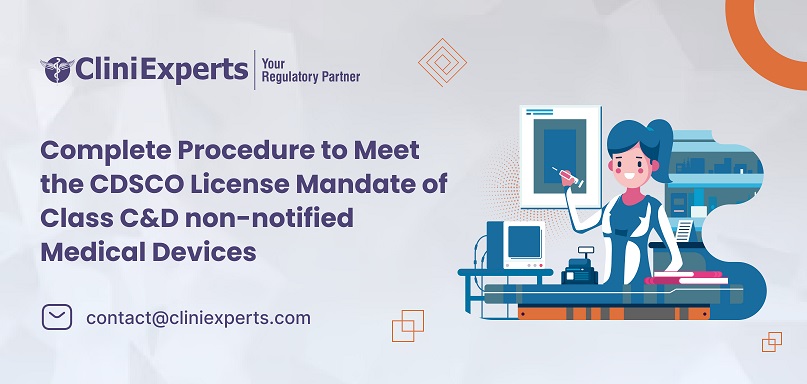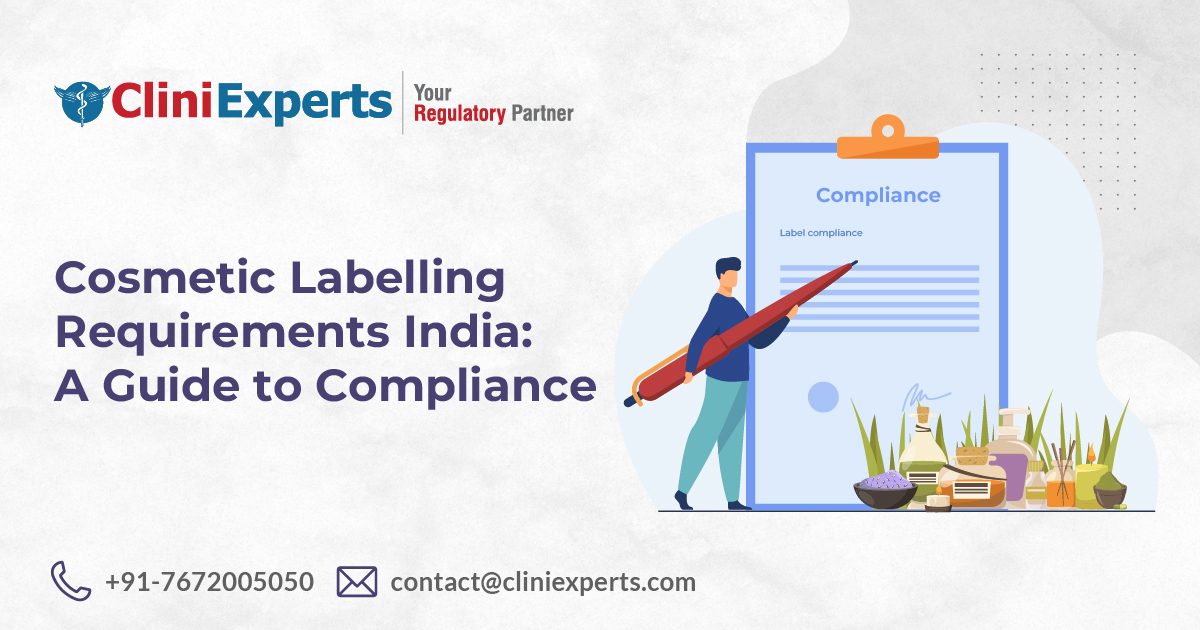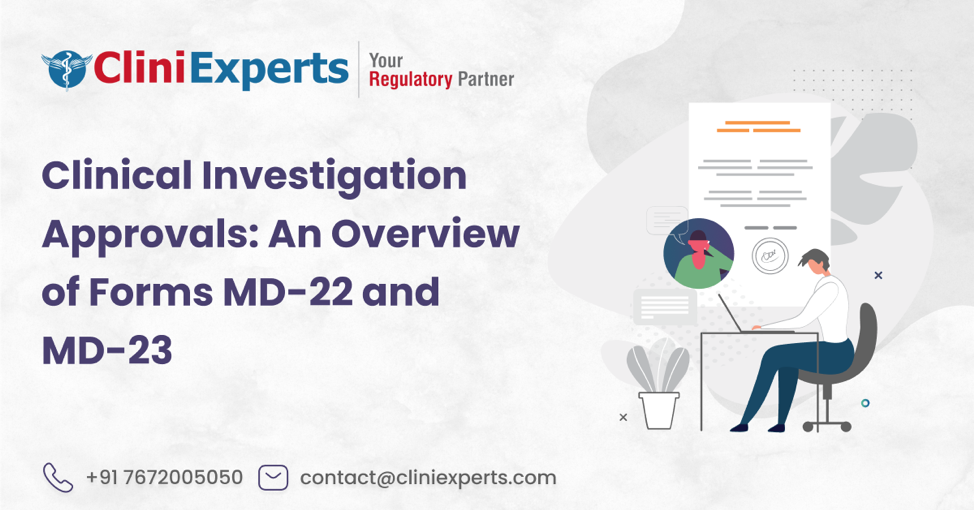Table of Contents
Complete Procedure to Meet the CDSCO License Mandate of Class C & D Non-Notified Medical Devices

Overview of the CDSCO License Mandate
The Central Drugs Standard Control Organisation (CDSCO) is the regulatory body that manages medical device registration in India under the Ministry of Health & Family Welfare. The main aim of CDSCO is to ensure that medical devices are safe and effective for the intended population. The Drug Controller General of India (DCGI) oversees the Classifications of Different Classes of Medical Devices by CDSCO, which regulates Different Classes of Medical Devices nationwide. According to the law, there are four categories of medical devices: A, B, C, and D. Medical devices are divided into four categories based on their dangers. According to GSR 102(E), dated February 11, 2020, the Medical Device Rule 2017 will now go into effect on October 1, 2023, and non-notified medical devices of classes C and D currently required to be registered need a license.
Scope of Class C & D non-notified medical devices
- Moderate high-risk and High-risk devices fall under Class C or Class D. The Central Licensing Authority is where the application must be submitted to manufacture these medical devices.
- Non-Notified Devices: Any devices not on the list of Notified Devices are not subject to regulation in India. The CDSCO portal needs to include a list of these devices. IAAs (Indian Authorized Agents) are required for foreign businesses that want to sell these devices in India.
- It is essential to note that the inspection required by the Medical Device Officers (MDO) of the Central Licencing Authority (CLA) under the Medical Device Rules (MDR) 2017 must be completed within 60 days (roughly two months) of the date of application to verify compliance with the Fifth Schedule of the MDR 2017. Acting quickly ensures a smooth transition to the new licensing system on October 1, 2023.
- To prevent any interruption in the supply of medical devices in India, the CDSCO will process applications for a pro-active grant of manufacturing/import licenses so they can be issued within the allotted timeframe (before October 1, 2023).
Is there a link to the portal?
https://cdscomdonline.gov.in/NewMedDev/Homepage
CDSCO requirements
- Class C and D devices have more demanding regulatory requirements due to their greater complexity. A few of the documents needed to register a device with CDSCO are listed below:
- Free Offers Authentication from the nation of origin
- Certificate ISO 13485
- Product specifics
- Design Master File (DMF), Plant Master File (PMF), and Power of Attorney (POA)
- Declaration of Compliance
- COA: Certificate of Analysis
Medical device registration with CDSCO is a time-consuming and challenging process. Depending on the device’s complexity, the time needed to register Class C and D devices can change. However, manufacturers can ensure a smoother and faster registration process by adhering to Regulatory standards and providing complete and accurate information.
Documentation
Device Master File (DMF)
- Device Master File refers to comprehensive product information that must be provided to the appropriate regulatory body in accordance with the requirements of Part III, Appendix II of the Medical Device Rule 2017.
- To demonstrate the safety and effectiveness of a medical device, the device master file must be created by the medical device manufacturer for each medical device or category. It must be presented unambiguously, clear, well-organized, and easily searchable.
Many manufacturers, while preparing the device master file, face difficulties in different sections such as medical evaluations, benefit-risk analyses, validations, design and development files, shelf-life stability studies, usability engineering files, safety and biological evaluations, and evaluations of chemical properties
Technical Documentation
Central Drugs Standard Control Organization (CDSCO) in India regulates medical devices, including Class C and D. Here’s a general guideline for the technical documentation required for Class C and D medical devices in India:
- Device Description and Specifications: Usually consist of the device information, its variants, accessories, manufacturer details, etc.
- Risk Assessment: Such assessments consider the potential physical risks associated with the equipment’s use, function, and incident history.
- Biocompatibility: It investigates how the device interacts with the various living tissues and cells exposed to it when it encounters patients.
- Clinical Data: Medical device clinical trials go through several stages to evaluate their effectiveness, safety, and potential side effects.
- Performance Testing: This testing is intended to obviate any mechanical or design flaws that could affect how well the medical device performs.
- Labeling and Instructions for Use: A thorough description of the medical device, including how it differs from rival products or earlier iterations of its device, should be included in the instructions for use (IFU).
- Quality Management System (QMS) Documentation: A structured system known as a medical QMS records the steps and processes used throughout the lifecycle of a medical device.
- Sterilization and Packaging: Sterile medical devices are packed to guarantee sterility until the point of use. The choice of packaging material is the most crucial step in packaging.
- Stability Testing (if applicable): Medical device stability testing evaluates how well a device maintains the same properties and characteristics that it did at the time of manufacture, within certain bounds, and over the course of storage and use.
- Declaration of Conformity: (DoC) is a legally binding statement that the manufacturer, or the authorized representative, has attested that all the products abide by all applicable regulations.
Application Process
| Applicant type | Application | License | Fees |
| Manufacturer | Form MD-7 | Form MD-9 | For one site, INR 50000, and INR 1000 for a medical device |
| Manufacturer (Loan License) | Form MD -8 | Form MD -10 | |
| Importer | Form MD- 14 | Form MD- 15 | $ 3,000 for one site and $1500 for one medical device unit |
Registration on the CDSCO SUGAM portal
Steps for Registration
- Examine the registered email for email verification after submitting the registration form.
- There is no need to register again if the applicant is already registered with CDSCO. The formulation data is filled out using the same user credentials.
- Use the Fill & Sign tools to complete the form if the Undertaking PDF has no interactive fields. Save the form to your computer, then launch Acrobat Reader to view it there.
- The person who signs the undertaking must self-attest all documents with the company’s stamp and seal.
- Uploading a copy of the state-issued manufacturing license is required.
Application Submission
Step 1: Preparing the Application – Preparing the application is the first step in the application process. The following details must be included in the application:
- A letter of inquiry.
- The form for applications.
- A duplicate of the manufacturing or import license.
- Specifications of the device include name, model, and details.
- Technical information about the device’s design, components, and manufacturing.
- Safety and performance information, including, if available, data from clinical trials.
- Information on packaging and labeling.
- Information on the testing and certification organizations used.
It’s crucial to ensure that all the data you provide on the application is correct and comprehensive. The registration process may take longer if there are gaps in the data or it needs to be more accurate.
Step 2: Submitting the Application – Once completed, the application must be submitted to the CDSCO. Both online and in-person application submissions are accepted at the CDSCO office. Depending on the class of the device, the CDSCO assesses a fee for the registration of medical devices.
Step 3: Verification of the Application – The CDSCO will check the application and any supporting documents after submitting it. The CDSCO will ask the applicant for more information if any of the submitted papers are discovered to need to be more accurate or complete.
Step 5: Inspection of the Manufacturing Facility – To ensure that the manufacturing process complies with the pertinent standards and guidelines, the CDSCO may inspect the facility. Typically, a CDSCO team of experts conducts the inspection.
Step 6: Decision by the CDSCO – The CDSCO will decide whether to register the device based on the Technical Committee’s recommendations and the inspection report. If the license is denied, the Central Licencing Authority, or CDSCO, notifies the applicant in writing of the decision within 45 days. The CDSCO will issue a registration certificate if the device is approved.
Step 7: Post-Market Surveillance – Following registration, CDSCO will carry out post-market surveillance to ensure the product complies with all applicable standards and regulations. Any adverse incidents involving the device must be reported to CDSCO by the device’s manufacturer.
Step 8: Compliance with Quality Management Systems – To certify the quality system(s) of the legitimate and/or actual manufacturing facilities, an ISO 13485 certification is necessary. Manufacturers must submit a Plant Master File (PMF) for each manufacturing site to demonstrate conformity. An import license is given upon approval, and any medical devices added thereunder are those authorized at that location. As a result, manufacturers with a single manufacturing location will only need one import license, while those with three locations will need three. Products made at two different facilities will need two PMF applications, and once approved, they will be listed on separate import licenses.
Renewal / Amendments
- Renewal Process: Manufacturers must renew their import license(s) every five (5) years to maintain market access in India, as stated in the Medical Device Rules, 2017. The first batch of import licenses approved under the new regulations is scheduled to expire later this year, in 2023, as a result of the Medical Devices Rules, 2017, being put into effect in 2018.
- Two steps are involved in renewing an import license: paying the retention fees and submitting the updated paperwork. As long as retention fees are paid, and new documentation is submitted every five years, import licenses for manufacturing facilities and medical devices are valid forever.
- Amendment Process: Updates to the product must be made separately because the system does not permit changes during the renewal. The manufacturer must certify during the renewal process that no modifications have been made to the product or manufacturing procedure. To avoid difficulties and delays in the license renewal process, which could prevent access to the market, manufacturers should exercise caution when it comes to license maintenance in India.
- Fee: The perpetual import licenses must be maintained by paying retention fees. A late fee will apply if the costs are paid after renewal.
- Timeline: 6 to 9 months.
Conclusion
Navigating the CDSCO License Mandate for Class C & D non-notified Medical Devices in India requires a thorough understanding of the regulatory landscape and a meticulous approach to documentation and compliance. The Central Drugs Standard Control Organization (CDSCO) plays a pivotal role in ensuring the safety and efficacy of medical devices, thereby safeguarding the well-being of patients.
As the Medical Device Rule 2017 takes effect on October 1, 2023, manufacturers and importers of Class C & D devices face a critical transition period. The mandate emphasizes the need for a proactive approach to secure the necessary licenses and registrations to continue supplying these devices in the Indian market seamlessly. The CDSCO License Mandate seeks to ensure that medical devices entering the Indian market meet stringent safety and efficacy standards. Manufacturers, importers, and all stakeholders in the medical device industry must work together to uphold these standards, contributing to the overall health and well-being of the population. As the regulatory landscape evolves, a proactive and informed approach will be the key to success in this dynamic and vital sector.
How CliniExperts can help – CliniExperts have more than 14 years of experience handling the regulatory pathway for different medical devices. Our internal expertise team has worked on other product portfolios and is known to address various challenges. A rigorous product testing regime must be established for medical devices. This regime includes a stringent compliance protocol and a wide range of testing parameters, including testing on various software. Permission for manufacturing is necessary after the test license is obtained. It is the responsibility of an experienced expert to fulfill these requirements. Attempts are made internally frequently not to waste time, money, and resources. The regulatory experts at CiliniExperts can handle it with ease.
Saurangi is a food regulatory expert with 8 years of experience. She shares her knowledge and insights on regulatory updates, food trends, best practices, and news. Follow her for expert insights and practical advice on all things for food regulatory
Saurangi Shah
CliniExperts Services Pvt. Ltd.
Recent Posts
Organic Food Labelling In India| Certification, and Import of Organic Food in India

This Article is All About Organic Food Labelling In India and Certification, and Import of Organic Food in India. Explained in Detail About What is Organic Food labelling? Summary Short Description Wi..
Cosmetic Label Compliance India : A Guide to Compliance

Introduction Looking for Cosmetic Label Compliance India? Are you a cosmetic manufacturer or importer navigating the complex world of Indian regulations? Ensuring your product labels comply with the l..
Clinical Investigation Approvals: An Overview of Forms MD-22 and MD-23

Summary Short Description Strict regulatory protocols govern clinical investigations for medical devices. Central to this process are forms MD-22 and MD-23. Form MD-22 is an application to Central Lic..
HAVE A QUERY?
REACH US!Office
New Delhi
Unit No. 324 & 325, City Centre Mall, Plot No. 5, Sector 12, Dwarka, India - 110075
+917672005050
Bengaluru
RMZ Galleria, 1st floor, Ambedkar Colony, Yelahanka, Bengaluru, Karnataka, India – 560064
Call us on
Sales: +91 7672005050
Reception: +91-11-45214546
Timings
9 am to 6 pm (Monday to Friday)


